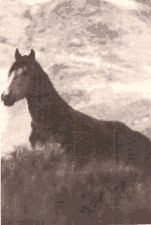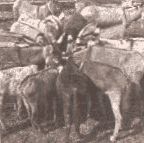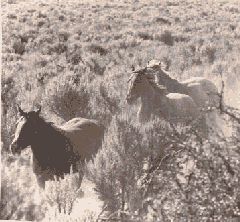Hauling any animal can be difficult - even more so if the
animal is excited or nervous. A few helpful hints:
It is preferred that once your animal is loaded that you
proceed directly to your destination; however, if you will be
traveling long distances, you may want to stop and rest. We
recommend that you do not unload your animal unless you have
arranged for appropriate facilities and have discussed the
arrangements with BLM. If you stop at a rest area, park away from
others so your animal will not be disturbed.
Animals may be transported for a maximum of 24 continuous
hours. After each 24 hours of travel, they must be unloaded into
an approved corral for watering, feeding, and resting for a
minimum of 5 hours, unless BLM has approved other arrangements.
For your own safety and to prevent any possible digestive
problems for the animal, don't attempt to feed or water the
animal in the trailer.
If you cross State boundaries, keep your animal's health
certificate and other records handy for inspection. State laws
vary. By checking ahead of time with any State whose boundaries
you will cross, you can be sure all legal requirements are
met.
For safe unloading, make certain the animal can go only into
the corral and cannot escape around the sides of the trailer or
through another open corral gate. Also, before opening the
tailgate, be sure that the animal is not tied in the trailer. Be
Make sure no one is in the animal's path as it backs out of the
trailer. Be patient if the horse or burro is resistant to leave
the trailer. It may be safer to walk away and allow the animal to
exit when it is comfortable. After the animal is in the corral,
don't forget to close the corral gate securely before moving the
trailer.
17. What facilities are adequate for a
wild horse or burro?
Until gentled, a newly adopted animal should be kept in a
corral with a minimum of 400 square feet for each animal, Fences
should be at at least 6 feet high for adult horses and 4-1/2 feet
high for burros. Horses between 6 and 18 months old may be kept
in corrals with fences 5 feet high. Ungentled animals should not
be turned out in a pasture or other large area until they can be
easily caught. (A wild horse or burro is considered gentled when
it can be approached, handled, and haltered and will not attempt
to escape a fenced enclosure.)
Adopted horses or burros do not require elaborate shelter, but
they must have protection from inclement weather in areas having
sustained temperature extremes, heavy or frequent precipitation,
or frequent high winds or dust conditions. Where extreme heat is
a factor, the animals must have shade. In most cases, wild burros
are more sensitive to extreme cold than wild horses.
For a gentled animal that is exercised daily, a box stall with
an area of 144 square feet (12' x 12') is acceptable as long as
it is well drained, well ventilated and regularly cleaned.
Animals not yet gentled must be kept in a corral with a properly
fenced area of at least 400 square feet (20' x 20') to allow the
animal to exercise.
Shelters and fences must be free from any protrusions (bolts,
hinges, nails, etc.) or other objects hazardous to the animal.
Fences should be constructed of rounded pipes, poles, wooden
planks or other materials that do not pose a hazard to the
animals. Large mesh woven or barbed wire is dangerous and not
acceptable for ungentled animals under any circumstances. After
gentling, the animal may be kept in a pasture of any type fencing
acceptable for domestic horses or burros.
An example of a "quick and inexpensive" compliant mustang pen
can be viewed here.
18. What should I feed my adopted wild
horse or burro?
 The major portion of the animal's diet should consist of
roughage - usually in the form of hay. Some grains and
supplemental feed may be required, depending upon the age,
condition, and amount of exercise the animal receives. Females
with foals will normally require a different ratio than idle
adult animals. Since meeting the nutritional requirements of the
animal is so important, we recommend that you consult with a
veterinarian to determine the most desirable ration for your
adopted animal.
The major portion of the animal's diet should consist of
roughage - usually in the form of hay. Some grains and
supplemental feed may be required, depending upon the age,
condition, and amount of exercise the animal receives. Females
with foals will normally require a different ratio than idle
adult animals. Since meeting the nutritional requirements of the
animal is so important, we recommend that you consult with a
veterinarian to determine the most desirable ration for your
adopted animal.
Clean, fresh water and trace mineral salts must be available
at all times. An adult horse needs 12 to 16 gallons of water
each day, and an adult burro needs 6 to 8 gallons daily,
depending on weather conditions. Feed and water containers should
be cleaned regularly. They must have rounded comers and edges so
as not to pose a hazard for the animal.
19. What are some tips for gentling a
wild horse or burro?
Every horse and burro needs to be gentled sufficiently to
allow people to work with and around the animal safely, even if
you don't intend to train it to ride. If you are unfamiliar with
training horses or burros, it may be wise to enlist the
assistance of an experienced trainer.
Do not remove the halter and lead rope placed on the animal at
the adoption site. They are useful in halter training the animal.
The halter should be checked periodically on young, growing
animals to assure that it does not become too tight.
In new, unfamiliar surroundings your animal will react out of
fear for its safety, so remember to gain its trust and confidence
through patience, kindness, gentleness. and consistency.
Always keep alert to ensure your own safety and to
keep from frightening the animal.
Spend time around the corral to let the animal become
accustomed to human activity.
Don't bring a group of folks around the animal
initially. Too much activity will startle the animal.
Move slowly and quietly to avoid frightening the
animal.
Spend time with the animal while feeding. For your
safety, feed through or over the fence at first.
Talk in a soothing tone of voice while the animal
eats. What you say isn't important, but how you say it
is.
 The newly adopted wild horse or burro is dependent on you for
feed and water, and it won't take long for the animal to make a
positive connection with you. After carefully establishing
physical contact and getting the animal accustomed to your
presence, you are ready to begin training.
The newly adopted wild horse or burro is dependent on you for
feed and water, and it won't take long for the animal to make a
positive connection with you. After carefully establishing
physical contact and getting the animal accustomed to your
presence, you are ready to begin training.
There are many different methods for training a wild horse or
burro. The approach you choose must be consistent with humane
treatment of the animal. Information on how to train a wild horse
or burro can be found in a variety of sources. In addition to
books and magazine articles, several videotapes demonstrate
successful training techniques. Your local librarian can help you
locate materials. You should also check with tack stores for
training books and videotapes. Some retail bookstores and
videotape stores may be useful sources. Another valuable resource
is the county agent for the Extension Service in your area.
20. What restrictions are there on the
use of an animal until I receive title?
 For the first year. the U.S. Government still owns the adopted wild horse or burro. While the animal is still considered a wild horse or a wild burro under the protection of the 1971 Act, it cannot be sold or used for any commercial purpose exploiting its
wild characteristics. Additionally, BLM will not issue title to
on individual who has expressed an intent to use the animal for
commercial purposes after title is passed. Once you have received
the Certificate of Title. the animal is no longer 'Wild' and
under the protection of the 1971 Act. It is then your property as
regulated by the humane laws of your State.
For the first year. the U.S. Government still owns the adopted wild horse or burro. While the animal is still considered a wild horse or a wild burro under the protection of the 1971 Act, it cannot be sold or used for any commercial purpose exploiting its
wild characteristics. Additionally, BLM will not issue title to
on individual who has expressed an intent to use the animal for
commercial purposes after title is passed. Once you have received
the Certificate of Title. the animal is no longer 'Wild' and
under the protection of the 1971 Act. It is then your property as
regulated by the humane laws of your State.
You don't have to wait until you receive title to train the
animal for personal uses, such as riding, roping. working,
showing. etc.
21. What should I do if I can no longer
care for my adopted animal before I receive title to
it?
If you haven't received title to the animal, contact the Wild
Horse and Burro staff in the BLM office for your area. (The
offices are listed at this link.) Even
if you find another person willing to adopt the animal. BLM must
check that person's qualifications and must approve the transfer
before the animal can be moved. The adoption fee cannot be
refunded nor can you be reimbursed for any expenses you have
incurred.
Once you have received title to a wild horse or burro, the
animal is private property. The BLM has no authority over the
animal after titling.
22. What should I do if the adopted dies,
escapes, or is stolen before I receive title?
If the animal dies, escapes, or is stolen while still under
the protection of the 1971 Act (that is, if you have not received
a Certificate of Title), notify the Wild Horse and Burro staff in
the BLM office for your area.
If the animal dies. written notification must be made within 7
days of discovery of death. Notification should include the
approximate date of death, apparent cause of death, and method of
carcass disposal. Carcasses must be disposed of in accordance
with your State's sanitation laws; however, the remains of a wild
horse or burro cannot be sold for any purpose. The BLM will
investigate the circumstances if the death appears
suspicious.
If an animal escapes or is stolen. you must notify BLM and
make a diligent effort to recover it. Adopters are responsible,
as provided by State law, for any personal injury, property
damage. or death caused by animals in their care, and for costs
of recapture.
23. What should I do if I change my
address or move my animal before I receive title to
it?
If you move your animal to another location and/or change your
address prior to receiving Certificate of Title, you must notify
BLM immediately. The new facilities may be inspected or otherwise
verified to ensure they comply with regulations.
24. How can I identify an adopted wild
horse or burro?
Each animal adopted after April 1978 has been individually
identified by angle symbols applied by a freeze mark on the left
side of its neck. The symbols include the animals birth year and
identification number. (Freezemarks are described in this link).
25. How can I learn more about caring for
horses and burros?
There is a wealth of printed material and videotapes available
about horses and burros. Libraries. bookstores, took stores, and
video stores should carry materials to suit your needs. The
Extension Service agent in your area can also provide
information.
Two particularly helpful books for general knowledge about
horses and horsemanship are Horses: A Practical and Scientific
Approach by Melvin Bradley (1981. McGrawHill Book Company)
and Horses and Horsemanship by M. E. Ensminger (1977. The
Interstate Printers & Publishers. Inc.)
Webmaster's Note:
Also check out Are You Considering Adopting a Wild Horse? presented by Barbara Eustis-Cross and Nancy Bowker

For a downloadable copy of this feature from BLM, please click Here.
This is not a BLM operated or BLM sponsored site. It
is run by private wild horse and burro enthusiasts. We are thankful to the
BLM for providing the information which is presented here.
